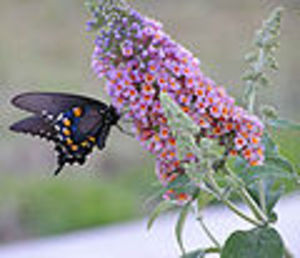Pipevine swallowtail caterpillars are named for their favorite host, the huge-leaved pipevine. As adult butterflies however, they enjoy many hosts that may be in your yard including azaleas, lilacs and petunias. How will you know if you share your homeland with pipevine swallowtail caterpillars?
What does the swallowtail caterpillar look like?
Have you ever heard of the phrase “they are so ugly that they are cute?’ Well, it really doesn’t apply here. The swallowtail caterpillar is really just amazingly ugly. At best, it is described as “wild-looking.” The swallowtail caterpillars are black and sometimes purplish black with orange spots that are not simply spots but rather look like raised nodes. They also have antennae but again, they are not simply slim protrusions but rather look like fleshy black arms. These fleshy black antennae that are of various lengths protrude from the both ends and the sides of the caterpillar and at places in layers. Imagine a creepy 3-D creature and you’re getting close. On the other hand, the swallowtail butterflies that emerged are quite attractive.
What does the swallowtail butterfly look like?
The swallowtail butterfly is quite attractive. While mostly covered in black tones, the upper wings have an iridescent blue and sometimes bluish green hue. The lower set of wings display an inverted “c” array of seven orange spots. Hence, the creepy orange nodules blossom into a beautiful pattern of orange dots. Not taking away from its’ beauty, black fuzz remains around the upper body of the swallowtail that is reminiscent of the transformed tentacles. The swallowtail butterfly is a miniature but hyped up version of ugly duckling becomes a swan.
Where will I find pipevine swallowtail caterpillars and butterflies?
As their name implies, the pipevine swallowtail butterfly love the huge-leaved pipevine plant that are most common in the mountains but can be found across the United States and in Mexico. This is where the caterpillar will lay their eggs. The eggs are an orangish color and are generally deposited on the freshest tips of the pipevine plants.
Young pipevine caterpillars will eat in groups but eventually roam out for solitary dining. The pipevine plants have chemicals that make them poisonous to other predators which is why you can find them grazing out in the open without any camouflage. Also the pipevine caterpillar has an osmeterium, which is an extendable fleshy organ that can release a pungent odor if the caterpillar becomes alarmed to ward off predators. The pipevine caterpillar “over winters” in a chrysalis that can be orange, brown or mostly yellow.
As adults they will feed on a variety of plants including thistle, lilacs, bergamot, azaleas, phlox, lantana, petunias, lupines, California black eye and gilias. If your homeland has any of these plants, there’s a great chance that you share your ecosystem with pipevine swallowtail caterpillars and butterflies.
If you want to spot the spotted swallowtail butterfly watch your step while you’re butterfly watching because their most favorite hang out is on fresh horse manure.
sources:
www.carolinanature.com/butterflies/pipevineswt.html
www.uky.edu/Ag/CritterFiles/…/swallowtail/swallowtail.htm
www.butterfliesandmoths.org/species?l=1350
